by Amy Plano | Apr 24, 2019 | General Nutrition
Did you know there are over 50 DIFFERENT names for added sugar ? Now, that is KRAZY with a capital K!
And let’s be crystal clear – I am NOT talking about the type that naturally occurs in fruits, veggies, whole-grain products as well as in dairy. We are talking about the sugar that is added to food during processing to enhance flavor, texture and shelf life.
Added sugar is typically composed of the either glucose, fructose and/or sucrose. Unfortunately, many food manufacturers are sneaky and hide the total amount by listing it under several different names on a package’s ingredient list.
As if reading labels wasn’t hard enough to begin with!
Any look familiar?

However, sadly the list does not end here my friends. Check out this quick article from Healthline to learn about the 56 (yes, you read that correctly!) other names that sugar goes by.
Talk about an unsavory alias!
Do any of these surprise you?
Raise your hand if you thought agave was a better choice than white sugar?
Surprised to hear that coconut sugar is a “no-go”?
That leads us to the next important question.
How much added sugar are you allowed per day?
Survey says…
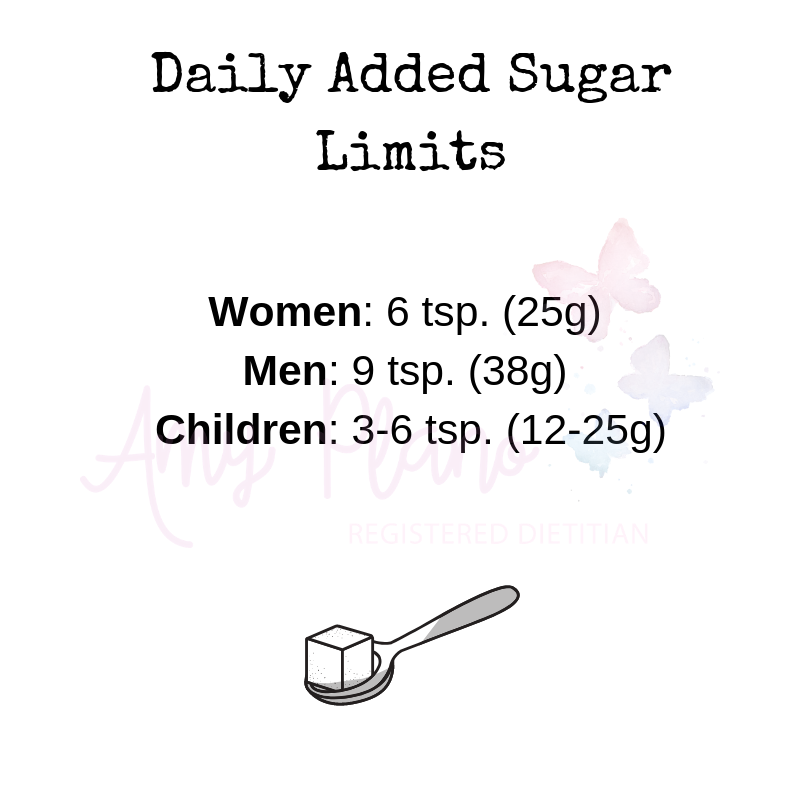
But let’s not sweat the small things. Whole foods like fruits, veggies, whole-grains and dairy products naturally contain small amounts of sugar. However, they are also nutrient powerhouses brimming with fiber, vitamins, minerals and phytonutrients. With these added features, whole foods are processed differently and don’t have the same detrimental effects of added sugars.
Therefore, the most effective way to reduce your added sugar intake is to J.E.R.F. – just eat real food. Plain and simple.
However, if you do decide to buy packaged foods, don’t be a slave to label. Be an informed consumer and stick to your daily quota.
Got questions on added sugars? Hit us up in the comments below. We understand this topic can in fact be tricky and we are happy to help!
Hugs & High Fives,

by Amy Plano | Apr 3, 2019 | General Nutrition, healthy snacks
Snacks – Open Those French Doors When you Get the Munchies
I confess. I am a snacker at ♥. I know some people just don’t eat snacks. They eat their 2-3 main meals per day and nothing in between. I my friends am NOT that girl.
Often I prefer to have snacks rather than meals. But not just one or two snacks. More like a personal ‘buffet’ of all things snacky. You see, my husband is not a snacker. Because well, tough guys don’t snack. Hee Hee! SO any and all snacks in the house are for me, myself and I.
A little guac, some hummus, a couple bites of scrumptious cheese, some raw veggies and maybe even a couple spoonfuls of full-fat Greek yogurt. That sort of stuff just makes my heart smile. It is like a party – but I am the only one there. After all, snacks are delicious. Right? I am just sayin’.
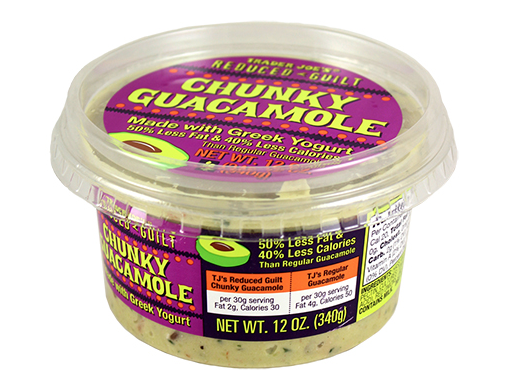
Trader Joe’s Guiltless Guacamole – one of my all time favorite snacks
Therefore, as a Registered Dietitian you probably don’t find it odd that I get tons of questions about snacks. I was trying to think if I could come up with a universal guideline when it comes to snacks. Then it hit me – mid ‘buffet’ line at my very own house: snack from the fridge NOT your cabinets.
Get Your Snack On
Fruit, veggies, yogurt, single-serving hummus & guacamole, cheese, and even leftovers are all super-duper healthy snack-a-roonies that all live in your refrigerator. Compare them with the snacks like chips, crackers, sweets and treats that typically reside in your kitchen cupboards. Therefore, looking to your your fridge when you get the munchies should be a no-brainer!
Set yourself up to succeed with healthy snacking by being proactive. Stock your refrigerator with healthy (and delicious!) options and make a solid effort to prep them ahead.
Wash and slice fruits and veggies BEFORE you even put them away when you return from the supermarket. Rock your Instapot to hard boil a half a dozen eggs. Can I say game changer! Or if you are super lazy grab some precooked hard boiled eggs from Traders. And no – they are not as sketchy as you might think. Stash leftovers in single-serving clear containers (so there is no guessing what is in them!). No leftovers? Pick up a ¼ pound of chicken or tuna salad from the deli. Both make for delicious snacks. Buy single servings of cheese like Baby Bels, mozzarella sticks and Laughing Cow. Then arrange your refrigerator so the healthier foods are front and center, making it more likely that they’ll be the first thing you reach for when you’re hungry.
Easy peasy! Now sit down and high five yourself. You worked hard. No get yo’self a snack.
Hugs & High Fives,

P.S. Never. Ever. Ever. Grocery shop when you are hungry! Here is actual footage of my cart at Trader Joe’s last week.
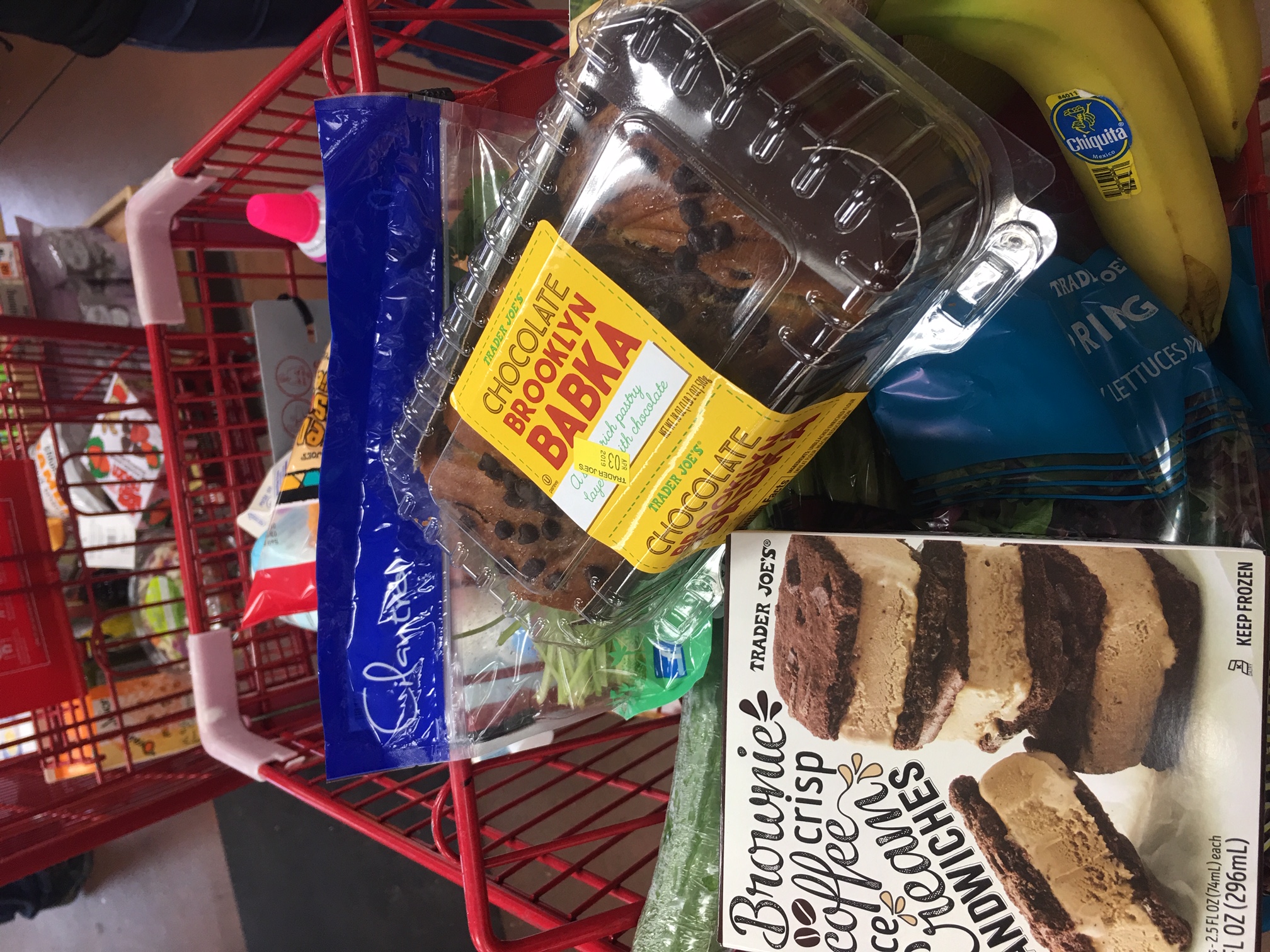
Dietitian Disaster!
I kid you not! There is pretty much about $150 worth of snacks in that cart 🙂 At least I bought bananas, right? Even dietitians have less than stellar days!
by Amy Plano | Mar 5, 2019 | General Nutrition, weight loss
J.E.R.F.
Today’s nutrition tip is brought to you by the acronym J.E.R.F. – Just Eat Real Food. There are a million ways to spin off of this word (and the relative term real) but the direction I am going to is with ‘pseudo’ foods. Bare with me … I promise you don’t need to eat cauliflower to feel the love.
Last week I posted this silly quote on social media:

And while it definitely made my chuckle – it also made me realize just how many foods we come across on a day-day basis are foods that have turned into things they really are not:
-
- Cauliflower pizza
- Cauliflower tots
- Cauliflower rice
- Mashed cauliflower
- Noodles made from zucchini, carrots, butternut squash
- Coconut ice cream
- Riced broccoli
- Impossible burgers– non-meat burgers that ‘bleed’ beet juice
- You get my point here 🙂
Cauliflower pizza IS NOT pizza.
And truth be told most versions don’t even remotely come close to the real deal pizza. In all honesty, most cauliflower pizza is not EVEN that much healthier. The crust is generally made with cheese, eggs and more cheese. I have nothing against cheese or eggs– but when you spec it out most can clock in just as high in calories as regular pizza depending on the toppings.
I love zoodles every. once. in and a while.
Of course they are a vegetable high in fiber, nutrients and vitamins and minerals. But what is wrong with having real pasta every once and a while? Yes – I know the carbs. But say you really love pasta why not just have the real deal occasionally in small amounts?
Riced broccoli — first of all have you tried it? It tastes just like broccoli! But are you surprised. Likely not because it IS broccoli.
Anything vegan trying to resemble meat – my only question is a big fat WHY?
Why not just eat real meat if that is the flavor, texture profile you are going for. I can only get away with saying that because I was a vegetarian for 10 years, a vegan for 2 years and a raw vegan for 1 year. I also used to have long dread locks and lived in Costa Rica – so go figure! Now I eat meat – love it – and often I am embarrassed to tell you that I used to eat something called “tuno.” No that is not an expensive Italian tuna in a high grade olive oil. Tuno was a ‘fake’ vegetarian based “tuna” that came in a can and smelled like tuna. Wicked gross.
Bottom Line
My point here is don’t eat foods because you feel like you have to. If you love riced broccoli then … rock on with your bad self! But don’t feel like you have to love it and convince yourself it tastes like rice. Because it certainly doesn’t! Also remember – you don’t have to be anyone or anything you don’t want to be. So why should your food be any different?
You don’t have to eat cauliflower pizza and ‘pretend’ it is delicious. Why not just head down to Modern Pizza once a month and tear it up? (When you do might I suggest the Veggie Bomb with hot cherry peppers!)
Furthermore, you don’t have to kill yourself and do a Whole-30 and deprive yourself of dairy when you love cheese. What are you going to do after you the 30 days? Will you never. ever. ever. return to eating your favorite food group? Survey says – I think not my friend! So why torture yourself and take something out of your diet you love. We have to be realistic with our food choices. If not then behavior change becomes unsustainable and we crash and burn every single time.
You see pizza, tater tots, rice and pasta are NOT the enemy. It is the way we abuse these foods and our relationship with them that makes them unhealthy.
Love yourself enough to eat the real deal
Do you think eating pizza or cheese for that matter will completely derail all your hard work? Hardly. Eating them every day – highly likely! But occasionally eating the foods you love — you know the ones that puts a smile on your face — should be part of your lifestyle These foods are not something you should try to replace. Because you and I both know there is absolutely no replacement for great REAL high quality food.
See part of the cool thing about the food we put into our bodies is that for many of us it is one the few things in life we can control. So why not make a pack to yourself that you are no longer going to eat something just because you feel like you should. You are no longer going to feel bad because you just don’t love spaghetti squash. Instead you are going to have a small serving of the real deal with some awesome sauce and homemade meatballs and call a night. You are not going to feel bad. You are not going to feel like you failed. Instead, you are going to be proud that you made a conscious decision to eat real food that made your little heart sing.
I wanted to leave you with some parting words 🙂

by Amy Plano | Feb 18, 2019 | General Nutrition, healthy eating, motivation Monday
I hope you are having an all-star start to your week. Coming off the weekend is alway tough. However, there is no day better than Monday to get back on track. It is time to shake off the Monday blues and bring your focus back to healthy eating. Your first stop – the grocery store. Today I am here to provide you with my three absolute BEST tips to grocery shopping like the champ you are. Put down that grocery store hater-ade and grab yourself a cart. Things are about to get fun!

Grab a cart and get your shop on 🙂
I ♥ grocery shopping
Grocery shopping is pretty much one of my favorite past times. I guess you could even call it a hobby of some sort! Anyone who knows me – knows I love grocery stores. No matter where in the world I might be I am constantly on the look out for grocery stores so I can check out the latest and greatest food finds.
However, with that being said shopping aimlessly is never a good thing. BAD things happen in grocery stores for Amy Plano when she does not have a plan. And I can only imagine the same goes for many of you! Please tell me I am not alone?
So today I am going to rattle off some of my top ticks for staying on track with your diet at the grocery store. I know none of these are new concepts to you. However, if you are like me, I can ALWAYS benefit from gentle reminders on how to improve my behavior.
Game plan it on Friday
I have a rule for myself on Friday afternoons. I cannot leave until I have written down at least two things I am cooking for dinner for the up and coming week. For the other meals I fill in the blanks with leftovers or go-to meals. Easy ones like baked chicken thighs or flank steak on the grill rounding out with some Trader Joe’s frozen veggies. However, I must have two concrete (not made up in my head as I have a tendency to do!) meals that I commit to making before I walk out the door. No ifs, ands or buts about it. That way when I go to the grocery store I am exciting about what I am buying.
I generally just pull up my Pinterest board called “Dinner” (yes – super original) and see what looks interesting and is hopefully in season. Here is the link for my dinner board in case you need some inspiration. Once I have identified the recipes I jot down the ingredients I will need in my spiral plain Jane notebook. This when I go home I know what I need and can compare it against what foods I already have.
A typical entry might look like this:
Monday: Baked chicken thighs, Trader Joe’s frozen sweet potatoes & broccoli
Tuesday: Egg Roll in a Bowl
Wednesday: Sushi
Thursday: Crock Pot Chicken Chili
Friday: Low Carb Chicken Quesadillas with cabbage lime slaw
Saturday: Out
Sunday: Flank Steak, Baked Potatoes and Salad
It is important to note these dinner recipes do not need to be fancy! Nor does your weekly ‘meal plan’ need to be elaborate. People get wrapped up in the semantics. They say to themselves I don’t know what to make that is healthy. Come on. You know what is healthy and what is not. You do not need me to tell you day-day what you should eat. These meals should be something everyone enjoys and resembles something relatively healthy. Depending upon your family the term relatively healthy likely means different things. But don’t sweat the small things.
Just write it down – the very act of writing things down help sets you up to succeed. Plan to succeed right from the start.
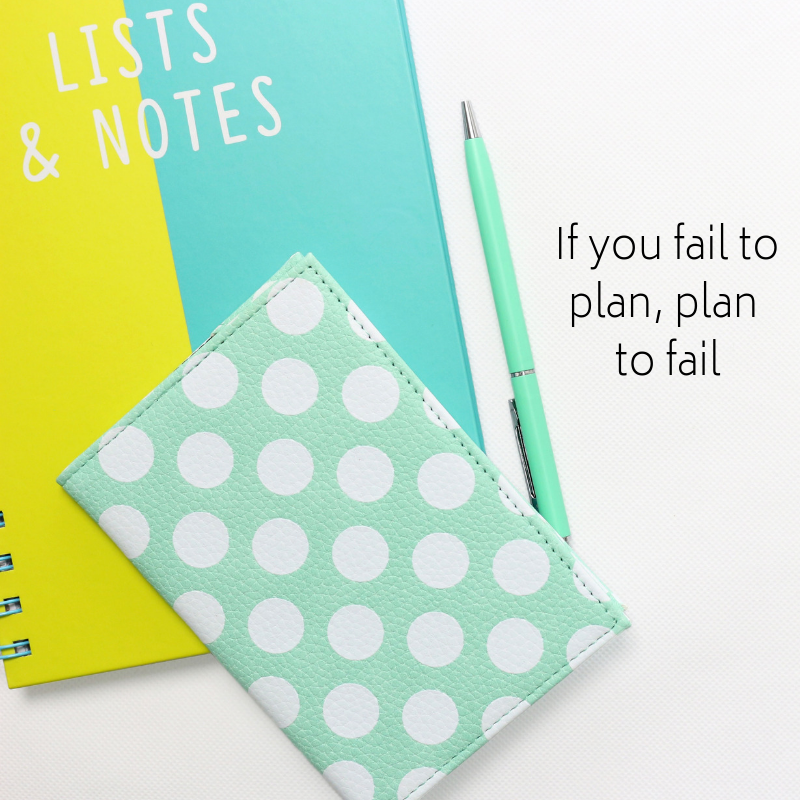
I know you have heard this quote a zillion times – but the message never gets old.
By planning ahead on Friday you will save yourself a ton of stress, time and money at the grocery store. It really puts YOU in the driver seat rather than leaving your meals to chance. So many of my patients do awesome all day with healthy eating. But then dinner rolls around and nothing is planned – so they reach for what is most convenient but not always healthy. They then beat themselves up. By coming up with a plan before the fact this can easily be avoided.
Because you and I both know when we go to the grocery store with no meals planned – food goes to waste and we come home with food but no meals = no bueno 🙁 It’s like having a closet full of awesome clothes – but no perfect “outfits”. We aint’ got time for that!
Make a list and stick with it
DO NOT step foot in any grocery store without a list. Okay – I admit I am the worst at this. However, we all need to raise the bar and follow through with grocery list making. Maybe I should start a self-help group for this? Honestly. I don’t care if you need to scribble the list down on a receipt you find in your purse. You MUST have a shopping list BEFORE you step foot in that grocery store.

Just write it down – the very act of writing things down sets you up to succeed
Shopping with a list is so critical. Not only does it save money because you are only buying exactly what you need – it also saves you from buying less than stellar foods that were not on your list. By making a list and sticking to it you can get in and out of the grocery store without cruising down every aisle wondering, “Do I need these delicious bourbon pickles from Traders?” – nope not on the list. Move on sista’!
The Type A person in me likes to arrange my list on how the store is set up. The list often starts with vegetables, then fruit, next protein and ultimately the dairy aisle. That way I don’t need to back track. Also the crazy dietitian in me likes to play a game when I grocery shop. I like to see if I can only manage to shop the perimeter of the grocery store. As it is really in the aisles that most people get into trouble with processed foods. Sometimes I am successful – sometimes not. However, I do make a point to spend more time out of the aisles if possible. But sometimes those Ghost Pepper Potato Chips do call my name in aisle 3.
Never ever shop hungry
I know this one is really a no brainer – but nothing good ever comes of going to the grocery store hungry. I don’t care what you eat – whether it be a meal or a snack – but dear friend please have something! If not everything looks good. You end up buying things that you would have never have even contemplated putting in your cart. If you go astray – always try to J.E.R.F. If you do that – then the damage might not be too bad.

And guess what? If it ends up in your cart – it ends up in your house. And if it is in your house — you will likely eat it 🙂
So why not avoid this nonsense all together? Keep healthy snacks in your car. Some suggestions include single serving packs of almonds, RX bars, single serving packet of trail mix, small bags of popcorn, and my personal favorite beef jerky.
Well my friends that is hopefully motivation on this Monday to get your butt in gear. Happy grocery shopping and hope to see you at Traders, Shop Rite, Whole Foods, Aldi’s or Costco or any other grocery store in between.
Need help navigating the jungle that we call the grocery store? Did you know the dietitians at The Plano Program conduct both one-one and group grocery shopping tours? Well we sure do! Email us us at amy.plano@yahoo.com to sign up.
Hugs & High Fives,

by Amy Plano | Feb 11, 2019 | General Nutrition, goal setting, healthy eating, meal prep
So, I gave you some time off last week from having to think too hard 🙂 But, I am coming back at you with a vengeance today. This week we are finishing up your favorite topic – good ol’ goal setting. So, grab your nutrition goals that you have been working on so diligently and let’s get to work!
To clarify once again these are the five key steps to goal setting to ensure your success. If you are coming in late to the game and want to revisit the first two steps of nutrition goal setting click here to read Part 1 of How to Crush your Nutrition Goals and click here to read Part 2 of How to Crush your Nutrition Goals.
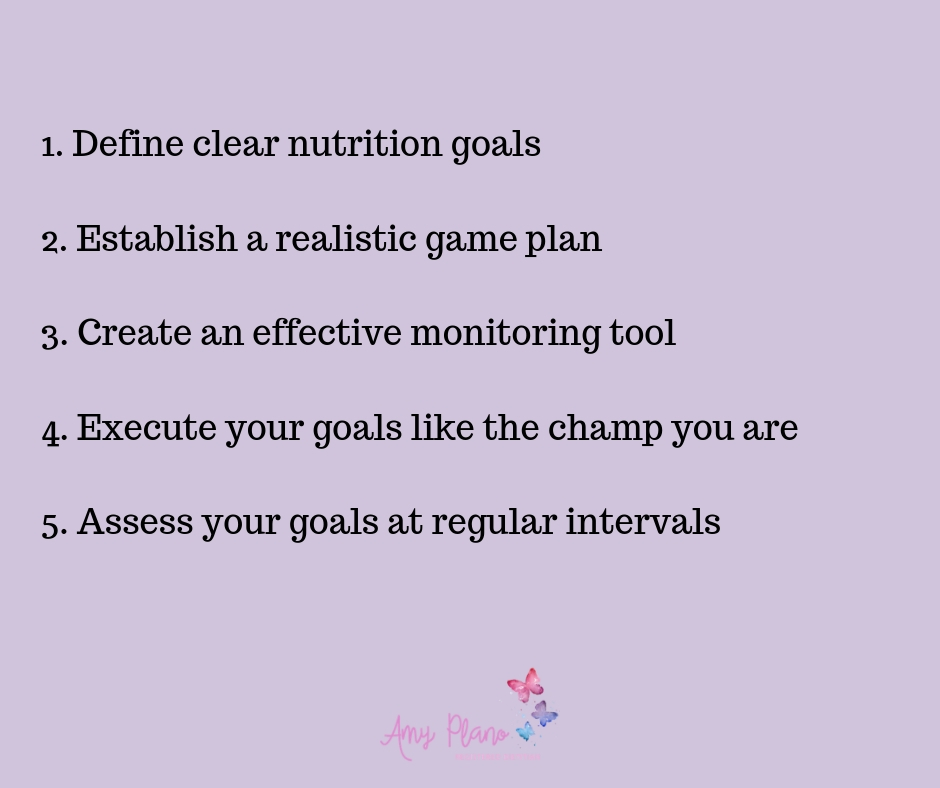
Consequently, this week we are tackling # 3: Create an effective monitoring tool, # 4: Execute your goals like the champ you are and # 5: Assess your goals at regular intervals.
#3 – Create an effective monitoring tool
So, you let’s recap. In short, so far we have helped you clearly define your S.M.A.R.T nutrition goals. Next we helped you set a realistic game plan. However, now you need an effective tool to monitor these goals.
You have heard the saying, “What gets measured, gets managed.” Well my friends, this certainly applies to setting nutrition goals. Pick a ‘tool’ – any ‘tool’ to manage your goals.
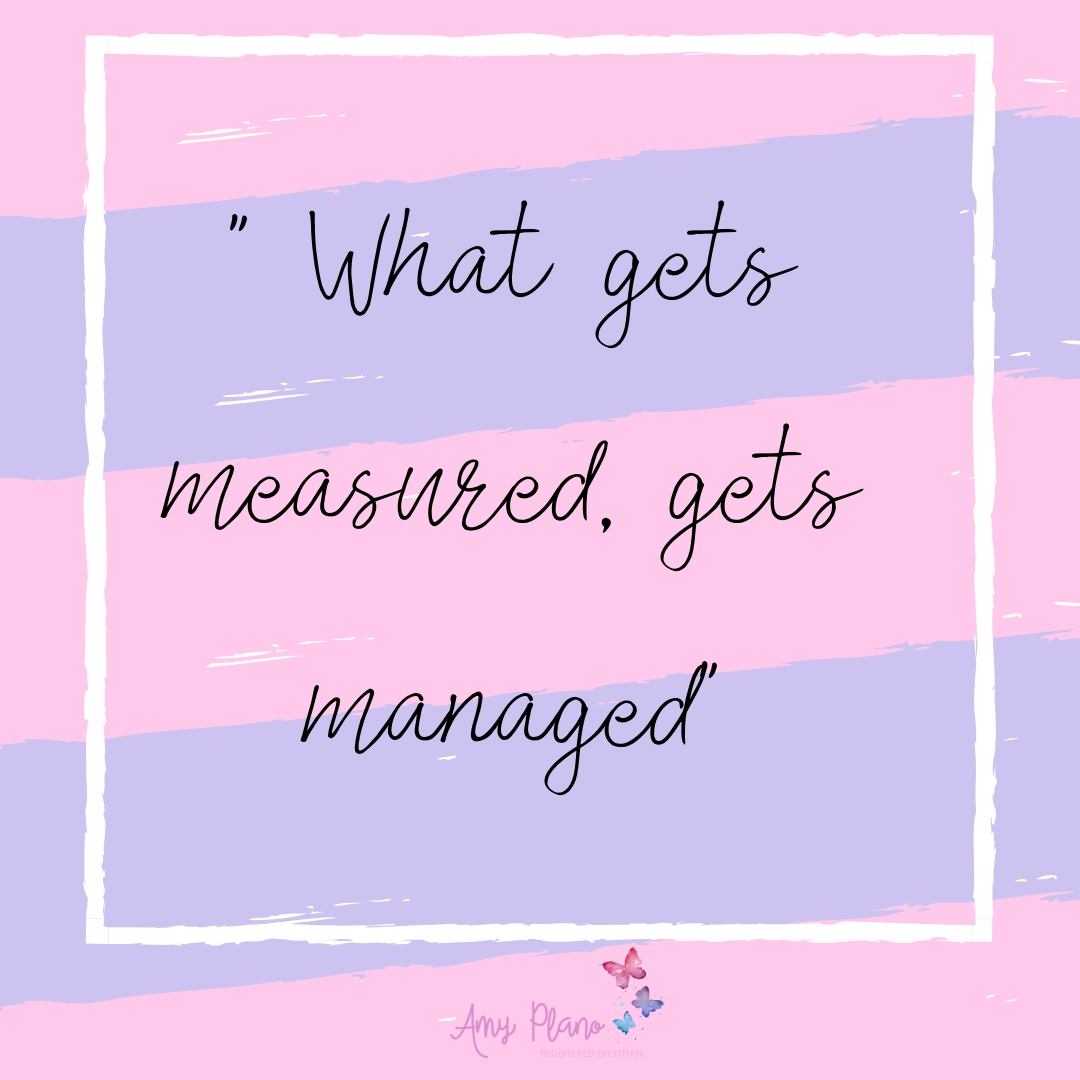
Below are examples of tools to help monitor and track your progress towards your nutrition goals. Please note depending upon what your personal nutrition or exercise goal is not all these tools may be applicable. I provide them just to demonstrate the various ways in which you can track your success.
- A FREE tracking app like ‘My Fitness Pal, Lose It or Sparkpeople
- An exercise journal
- A food journal
- Physical body assessments like body fat percentages as well as waist, hip, bust and bicep measurements
- A real, live person to report your successes to weekly (like an accountability buddy!)
- An exercise tracking device like an iwatch or fitbit
- Before and after pictures
- Lab values
- Performance markers like amount of weight lifted, time trials, Vo2Max, ect.
Notice many of them are by no means fancy. But all of them get the job done. However, keep in mind the best monitoring tool is the one you are likely to consistently use.
I am old-school and use a good old fashion journal. For some reason I feel much more comfortable writing my goals down.

But you may find that boring and rather log your food or nutrition in an app. Whatever you choose – just stick with it!
#4 – Execute your goals like the champ you are
Just. Do. It. In order to be successful with your goals, you need to be 110 % committed to taking action. Talk is cheap. And just like Benjamin Franklin once said “Well done is better than well said.” I don’t think anyone can argue with that.
So, put on your blinders. Get comfortable being uncomfortable and just do it. Pull out your goals each every morning and every night. Focus on what is important NOW! Because I hate to be the bearer of bad news but If you don’t prioritize your goals and life for that matter – someone else will.
#5 – Assess your goals at regular intervals
Remember your nutrition and exercise goals are not carved in stone. In other words, they should be dynamic and evolving in nature. Therefore, it is important to revisit them at regular intervals and make sure they are serving you. Here are some questions to ask yourself when assessing your goals:
- Am I happy with my progress? Yes? No? Why?
- What am I most proud of and why?
- What do I need to be doing differently to ensure my continued success?
- What are repeated barriers that are standing in my way to succeeding? How can I bullet-proof them?
- How can I high-five myself for a job well done?
- What is the next behavior I want to tackle and why?
My new favorite quote is from the book You are a Badass by Jen Sincero. I think it pretty much sums up goal setting perfectly, “There is nothing as unstoppable as a freight train full of fuck-yeahs.”

In conclusion, hone your goal setting skills, take your health seriously, DO what you need to be successful, invest in yourself, practice your ass off, fail, fall down, but above all get right back up. Repeat 🙂
Hugs & High Fives,

P.S. Having a hard time getting back up? Heck we have all been there! Feel free to reach out to the dietitians at The Plano Program to set up a consult to help get you on track to where you want to be going.
P.P.S. Love yourself – you are capable of anything.
by Amy Plano | Feb 11, 2019 | General Nutrition, goal setting, healthy eating, meal prep
SO if you know me at all – you know that I love to cook! Therefore, it is no surprise that one of my favorite websites is called The Kitchn. If you have not checked it out it is a fun website geared towards the home cook. They offer articles on everything from cool new gadgets to Whole-30 compliant recipes. It is a food dork’s black hole. Therefore, please be warned you can really get lost on the site 🙂 Most importantly, their latest and greatest resource? A weekly newsletter aimed at
healthy meal prep.
Sign. Me. Up.
In January of this year The Kitchn started offering a FREE
Meal Prep Newsletter in which they send out a weekly email that features doable plans and helpful recipes so you can prep, cook, and eat for the week ahead. The best part – they think of the healthy recipes so you don’t have to.

Free newsletter with healthy meal prep options? Sign me up!
Most importantly did I mention this newsletter is FREE – delivered straight to your inbox 🙂 If that is not a win – then I don’t know what is.
You Know YOU Wanna
Above all in my heart of hearts, I honestly feel like most people want to eat healthy. However, I also feel like most people don’t take the time to do the necessary things to set themselves up to succeed – like meal prep. Call it laziness. Call lack of focus. Call it whatever you want. Most people have solid nutrition goals – they just choose NOT to make them a priority.

Photo credit: Wooden Earth Cutlery
A couple of weeks ago we talked about the importance of goal setting. We actually used the example of meal prep. If you need a little refresher on goal setting click here for the full details. Success means not only shopping for the right foods but also engaging in meal prep. Furthermore, I think this quote pretty much sums up successful meal prep.
“Success is where preparation and opportunity meet.” — Bobby Unser
Therefore, when you and your family are 50 shades of “hangry” there is awesome, tasty, healthy food available.
Just Do It
So I encourage you to sign up for this newsletter. I think it could be very helpful. A resource like this has the potential to provides SO many things – inspiration, focus, motivation and even a definitive answer for the age old question, “What’s for dinner?” And after all, who does not want to learn how to cook fast, shop smart, and eat well? I know this chick does!
Need Additional Inspiration?
Sorry there is no other way to put it. I am a Pinterest whore. I simply ♥ Pinterest.

Sometimes I just want to look at pretty food. Is that too much to ask?
So if you need a little ‘pick me up’ or a bit of inspiration follow my modest Meal Prep Pinterest board. Also if you are just looking for suggestions for dinner please follow my main pinterest board with all sorts of healthy dinner options! I have over 2000 healthy recipes Amy Plano approved 🙂 Get your eat on!
Hugs & High Fives,



















